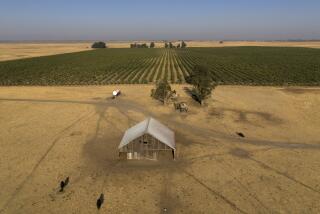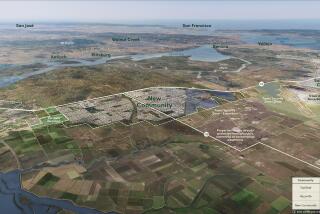Vision 2020 Aims to Put Simi Valley Future in Focus
SIMI VALLEY â Picture a city with safe streets, pocket parks, a regional shopping mall, aesthetically pleasing design, open space galore, and plenty of jobs in the technology, entertainment and medical fields.
Donât forget first-rate schools, a bustling main street with upscale restaurants and gurgling fountains, a full-service courthouse and nary a gang.
Now picture Simi Valley.
If those two visions arenât the same, they should be reconciled within 25 years. So says Vision 2020, a road map for Simi Valleyâs future that will be presented to the City Council tonight.
The fruit of two yearsâ work, Vision 2020 is an ambitious document that tackles development, economics, the environment, regional issues, safety and social concerns. In 166 pages, the document details how this city should age from young adulthood to comfy middle age with suggestions both pragmatic and idealistic.
âTo me, its a realistic approach for developing the city into what we hope for by the year 2020,â said Tim Hodge, chairman of the Vision 2020 executive committee. âThere are two main principles in it. Oneâs a desire to maintain a small-town atmosphere in a town which frankly isnât a small town. The second is to maintain a sense of community and a safe environment in which to bring up your children.â
Mayor Greg Stratton first proposed the sweeping project in 1994, as this bedroom city of 100,000 turned 25. He couldnât help but wonder what the city would look like at its 50th birthday, when population is projected to reach 140,000.
From that kernel of an idea came a survey of 10,000 residents--returned by 3,000 of them--and a 200-person brainstorming session at the Ronald Reagan Presidential Library. Then came a year of committee meetings and finally, the bound document: 1 1/2-inch thick, full of research, proposed municipal code revisions, architectural drawings, maps, photographs and appendixes.
âI think the thing Iâm most impressed with is the tremendous amount of work the community put into this,â Stratton said of the document. âWe envisioned this as a warm and fuzzy long-range plan. Yeah, thereâs that, but there are also some short-range, specific actions to take.â
The council will discuss the document tonight, make changes or additions, and eventually decide whether to reject or accept the plan. At the meeting, council members will also recognize the people who sweated over the documentâs every sentence and recommendation.
If the council approves the document, staff members will develop an implementation plan within six weeks, said Diane Jones, the cityâs environmental services director.
For about 80 people who sat on Vision 2020âs various committees and labored over language, topics and disagreements, the document might as well be a first novel.
âWeâre all people with very strong ideas of how we want to see not just our city, but our world, turn out,â said Joy Sanders, who worked on the environmental portion of the document. âAnd we need these ideas, because there are a lot of things wrong with our world.â
Among the documentâs many recommendations:
* Keeping safety first in this, the nationâs safest city with a population over 100,000, by maintaining a ratio of one sworn police officer to every 1,000 residents; supporting the creation of a juvenile justice center closer to Simi Valley, possibly in Camarillo; and expanding the East County Courthouse in Simi Valley by accepting juvenile and criminal cases.
* Attracting jobs with salaries of $50,000 or more in the software, entertainment, banking, insurance, communications and medical sectors.
* Preserving open space, greenbelts and parks and possibly creating a nature center with a trail system at Corriganville Park.
* Boosting the struggling Tapo Street with benches, fountains, boutiques, coffee shops and upscale restaurants; a similar concept is envisioned for the area surrounding the Simi Valley Cultural Arts Center.
* Reducing air pollution by encouraging businesses to offer incentives to employees who carpool or bike to work.
* Keeping growth in check and extending an existing growth control measure when it lapses.
* Creating a viable regional mall at 1st Street and the Ronald Reagan Freeway, possibly one with a movie theater that could be converted for other cultural events too big for the existing arts center.
* Improving aesthetics with landscaping, architectural design and sign manuals that address everything from lampposts to sidewalk heights, and âstreet furniture,â such as fountains, benches, clocks and sculpture.
* Monitoring ground water safety near Rocketdyneâs Santa Susana Field Lab.
More to Read
Sign up for Essential California
The most important California stories and recommendations in your inbox every morning.
You may occasionally receive promotional content from the Los Angeles Times.









